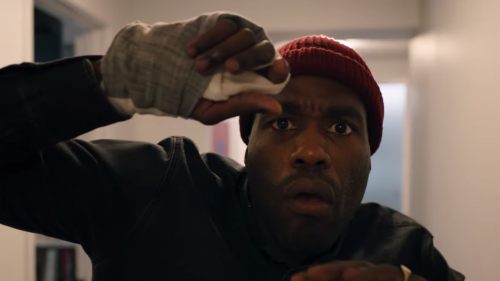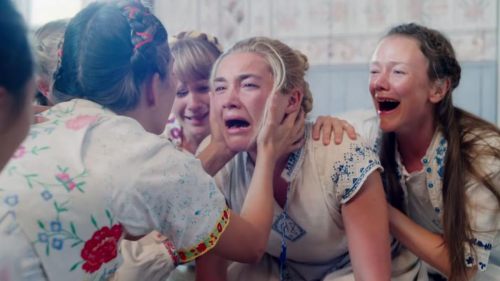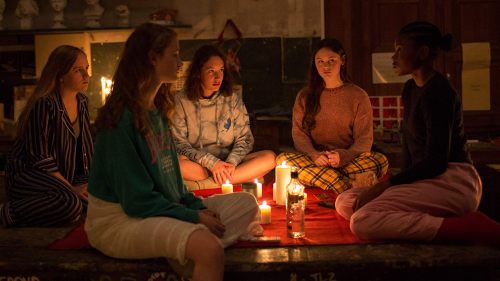The Savage Stack - NIGHT OF THE LIVING DEAD (1990)
There’s always going to be – for lack of a better term – a stack of films we’ve been meaning to get to. Whether it’s a pile of DVDs and Blu-rays haphazardly amassed atop our television stands, or a seemingly endless digital queue on our respective streaming accounts, there’s simply more movies than time to watch them. This column is here to make that problem worse. Ostensibly an extension of Everybody’s Into Weirdness (may that series rest in peace), The Savage Stack is a compilation of the odd and magnificent motion pictures you probably should be watching instead of popping in The Avengers for the 2,000th time. Not that there’s anything wrong with filmic “comfort food” (God knows we all have titles we frequently return to when we crave that warm and fuzzy feeling), but if you love movies, you should never stop searching for the next title that’s going to make your “To Watch” list that much more insurmountable. Some will be favorites, others oddities, with esoteric eccentricities thrown in for good measure. All in all, a mountain of movies to conquer.
The eighty-third entry into this unbroken backlog is Tom Savini's reverent remake of his mentor's horror landmark, Night of the Living Dead...

On October 1st, 1968, a crude, black and white movie named Night of the Flesh Eaters was set to premiere on 14 screens in Pittsburgh, Pennsylvania. Crafted by a scrappy crew of local filmmakers who shot mostly on weekends in-between paying gigs, Flesh Eaters was locally advertised via ads designed by the father of director and co-writer, George A. Romero. However, the production was served by another entertainment collective prior to its debut, claiming they'd already made and were profiting from a picture titled Night of the Flesh Eaters, and that any exhibition of a new film with the same title would be an infringement on their livelihood, and thus subject to further legal action. By necessity, Night of the Flesh Eaters became Night of the Living Dead and prints were struck with that moniker for its big bow.
During the process of renaming the movie, a re-organizing Continental Pictures failed to place a copyright notice on the Living Dead print. So, while the picture grew in popularity – with many critics and audience members claiming it was the "scariest movie ever made" – others outside of this Steel City creative family began striking their own celluloid copies for drive-in showings around the country, as there was nothing legally stopping them from essentially bootlegging Night’s regional expansion. Thus, Romero, co-writer John A. Russo, and co-producer Russell Streiner had to chase folks down to try and collect any sort of compensation they were owed, and even then there was no real recourse for them to get paid. Night of the Living Dead became a massive box office hit (especially considering it was so cheaply manufactured), and its creators barely saw a dime from those profits.
Thus, a remake was born. Russo claims he began dreaming up a redux as early as ‘86, as a means to not only collect on the movie's now iconic name – not to mention Romero's two subsequent sequels: Dawn of the Dead ('78) and Day of the Dead ('85) – but also to firm up the copyright in a roundabout fashion. So, Russo, Romero and Streiner partnered with B-Movie mogul Menahem Golan, who'd recently taken over 21st Century Film Corporation after his trashy cinema factory Cannon Films (which he'd run for most of the last decade with cousin Yoram Globus) went bankrupt. Coming along for the ride was SFX wizard Tom Savini, who was set to make his feature directorial debut after becoming the King of Splatter during the '80s via his work on Dawn, Friday the 13th ('80), Creepshow ('82), Day of the Dead and many, many other seminal scare pictures.
For Savini, this new Night of the Living Dead was also an act of reclamation, at least to a certain extent. In '68, Romero showed up to the budding makeup man's high school, looking to cast a production that never came to fruition. Knowing the filmmaker was working on Night, Savini followed Romero around with a homemade portfolio he'd been crafting ever since seeing James Cagney play legendary silent era Lon Chaney in Man of a Thousand Faces ('57). The director apparently agreed to let Savini design the creatures in his lo-fi opus, but Savini was drafted and had to serve as a combat photographer in Vietnam instead. The two wouldn't work together until Romero's vastly underrated vampire opus Martin ('78), where Savini would creatively apply some of the horrible imagery that'd burned into his brain overseas; the lens of his still camera separating the young soldier from this real world "gore".
‘78 also saw the release of what arguably still stands as Savini's most instantly recognizable SFX output, as he slathered Romero's now colorized (but still shambling) zombies in bright pink plasma with Dawn of the Dead. The sequel to Night finally gifted Savini the chance to create a horde of his own flesh eaters, and then chop their limbs off, plant machetes in their skulls, and shoot them with machine guns (not to mention act in the front of the camera as an unruly biker, which was always the goal he was hoping his “magic tricks” would achieve). There was even a moment – as our central escapees pilot a chopper over rural PA – where we’re essentially allowed to visit the same “Pennsyltucky” arena in which Night was set, with Savini (as if trying to make up for lost time) applying his gruesome touch.
Night of the Living Dead ’90 is much more than simply a colorization of Romeo’s classic (an ill-advised feat several producers would embark upon to disastrous home video results). With the aid of a Romero-penned screenplay, Savini is mashing modern horror sensibilities with one of the genre’s primary influences. The basic story structure remains the same – following a group of survivors holing up in a farmhouse on the eve of a zombie apocalypse – with line replications lifted verbatim out of the crude, B&W zombie progenitor. However, Savini toys with our knowledge of the original while simultaneously pretending like those unprotectable prints never existed in the first place, resulting in a movie that strives to stand on its own two undead legs as its opaque, milky eyes wink at us.
Perhaps the greatest update to this iteration of Night is Patricia Tallman’s Barbara. Though the character is introduced in the same fashion as her ’68 counterpart – bickering with her brother Johnnie (Chop Top himself, Bill Moseley, stepping into Streiner’s shoes) – her evolution over the course of Savini’s take forgoes Judith O’Dea’s shocked catatonia in favor of a post-Laurie Strode/Ellen Ripley “Final Girl” archetype. Tallman becomes our guide to this escalating end of all things, slowly finding the strength to survive until she’s strapping shotgun shells across her chest and unloading a blast into the dome of her primary adversary, adding a new spin to the infamous “another one for the fire” moment that caps both versions. A Romero refugee (having appeared in the master’s Knightriders [‘81] and Monkey Shines [‘88]]), this nuevo “Barbra” is an oft-forgotten example when discussing how the “Final Girl” mold progressed throughout the ‘80s outside of the slasher subgenre that birthed it: strong, sexy and warranting her own franchise by the final reel.
There’s always been some hazy rationale behind why Romero cast a black man as the lead of Night, with many critics during the two decades since the original movie’s release assuming some radical racial commentary. Romero has always maintained that Duane Jones was simply the best actor the production knew, so he was naturally the right fit for Ben, a harried survivor type, constantly side-eyed by his Caucasian counterparts. Unsurprisingly, Savini knew he needed to lean into this aspect of his remake, and cast future Candyman Tony Todd after the actor reportedly memorized his sides (and even transformed them into tears) during a five-minute audition. Todd is doing Capital A acting in Night ’90, screaming to the heavens at God for damning humanity before hollering at probable racist Harry Cooper (Henry: Portrait of a Serial Killer’s ['86] Tom Towles) after the suited family man bluntly comments “you don’t exactly look like neighbors”. Todd is incredible in the role, delivering intense monologues and seemingly running on pure exhausted fear at all times.
Beyond using Todd and Towles to heighten the movie's themes of racial schism in the post-Cold War/Vietnam portion of American history, Romero’s script inserts lines about the zombies (which are wisely never referred to as such) maybe being created by everything from voodoo mysticism to CDC doctors hypothesizing that a new contagion has entered our ecosystem (a possible half-assed reaction to the burgeoning AIDS crisis). Television news transmissions give way to primitive rednecks enacting martial law and using the zombies as fleshy playthings, with Barbara commenting “they’re us and we’re them” from a distance. Savini is acknowledging the series' usage of the monsters as tools for societal commentary, leaning into the satirical elements that became prominent in Dawn and Day (going as far as to replicate Civil Rights era atrocities during the movie's freeze frame credits), while still delivering the splatter goods horror fans who lived through the '80s slasher boom were undoubtedly expecting from his debut behind the camera.
Savini has always considered himself a magician, his “sleight of hand” simply convincing us of the gnarly ways bodies can be mangled and mutilated onscreen. Seeing how a solid chunk of his Night is set during broad daylight (before transitioning to a seemingly endless darkness), he exploits the sunshine to a rather impressive degree, allowing the audience’s eyes to linger on the rotting flesh of these new stumbling, hungry corpses. By the beginning of the ‘90s, zombies had arguably lost a chunk of their ability to frighten us, thanks to Romero-free rip offs and parodies (such as Dan O’Bannon’s brilliant Return of the Living Dead [’85]) and Michael Jackson utilizing the creatures in dance routines for his iconic "Thriller" (’83) music video. Savini again is taking the monster back to its roots, but dressing them up in a grotesque fashion all his own. You can really feel the SFX guru and his team having a ton of fun coming up with new ways to gross you out, to the point that the MPAA took issue with original cuts of Night ’90 (namely: the nasty headshots) and awarded the movie an ‘X’ rating before it was cut down to an ‘R’ for release.
Unfortunately for everyone involved, nobody wanted a remake of Night of the Living Dead, rendering the initial motivation for making the movie (money) somewhat moot. For most horror fans, the very concept of redoing the zombie classic was sacrilege, despite the fact that the original’s inventors were the primary creators involved. Roger Ebert – proving again to be an unreliable source for genre criticism – commented in his review that Savini’s version is “so close to the original that there is no reason to see both” (making one wonder if he was even paying full attention). Nevertheless, time has been kind to the makeup man's re-imagining, as its influence (intentional or not) can even be felt in many succeeding horror revivals, including David Gordon Green’s direct sequel to John Carpenter’s Halloween. This is a remake that respected the source, while recognizing its core audience would be expecting something entirely different from a new version, thanks to how the horror genre had progressed in Night's wake. Like the movie does with the title, it’s time to reclaim Night of the Living Dead as one of the best of its breed within a genre known for recycling its most inspired titles.
Night of the Living Dead (1990) is available now on Blu-ray, courtesy of Sony Home Entertainment.



